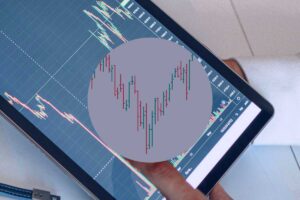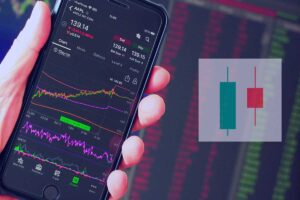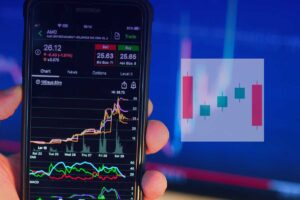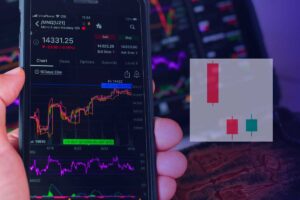Black Monday of 1987 refers to the historic stock market crash that occurred on October 19, 1987. It is characterized by a sudden and severe decline in global stock markets, particularly in the United States, with the Dow Jones Industrial Average (DJIA) experiencing its largest single-day percentage drop in history. The crash was triggered by a combination of factors, including concerns about rising interest rates, overvaluation of stocks, program trading, and investor panic.
Black Monday of 1987
Black Monday refers to the events that unfolded on October 19, 1987 when global financial markets, particularly in the United States, experienced a severe and sudden crash. On Black Monday, the Dow Jones Industrial Average (DJIA) plummeted by 22.6%, which remains the largest single-day percentage decline in the index’s history.
On this day, stock prices plummeted at an unprecedented rate, leading to widespread panic selling, massive losses for investors, and significant disruptions in financial markets worldwide. Despite the dramatic decline, the underlying economic fundamentals were relatively stable. The crash was primarily driven by a wave of selling triggered by automated trading programs and widespread fear among investors.
Following Black Monday, regulatory reforms were implemented to address some of the issues that contributed to the crash. These reforms included circuit breakers to temporarily halt trading during periods of extreme volatility and improved risk management practices.
Performance of Markets and Key Indexes on Black Monday
On Black Monday, the Dow Jones Industrial Average (DJIA) lost 508 points, marking a record drop in points at that time. In percentage terms, it fell by a staggering 22.6% in a single trading session, a loss that still remains its largest one-day percentage decline.
- The percentage-wise drop in the DJIA surpassed its second-largest single-day drop, which was 12.8 percent on Black Thursday of October 28, 1929, by almost double.
- This decline was in addition to a decrease of approximately 10.42% in the DJIA in the three trading days prior to October 19.
The S&P 500, a broader index representing the performance of 500 large-cap U.S. companies, also experienced significant losses on Black Monday.
- The S&P 500 index fell by 58 points, a decline of 20.48%.
- This was in addition to a decline of approximately 10.12% in the three trading days prior to October 19.
The NASDAQ Composite Index, which primarily includes technology and growth-oriented stocks, was not immune to the carnage on Black Monday.
- The NASDAQ fell by 46 points, representing an 11.35% decline in its value. Though this may seem less severe compared to the declines in the DJIA and S&P 500, it was primarily due to many dealers stopping trading early on October 19.
- On the following day, October 20th, the NASDAQ fell by another 9.00%.
Among other indexes, the Wilshire 5000 declined by around 23%, and the Russell 2000 index dropped by around 12.5% on Black Monday.
Billions of dollars in market capitalization were wiped out within a matter of hours, making it one of the most dramatic single-day crashes in financial history.
- In the U.S., on Black Monday, an estimated $500 billion was wiped out in market capitalization in a single trading session.
The volume of trading was exceptionally high as panic selling gripped the markets. Millions of shares were traded within a short period, reflecting the intense selling pressure and investor uncertainty during the crash.
- On the New York Stock Exchange, a record volume of 604.33 million shares traded hands that day, three times the daily average.
- This was almost double the previous record of 338.5 million shares, which was set just the previous trading day, on October 16.
As news of the crash spread, markets around the world experienced sharp sell-offs, with investors rushing to exit positions amid fears of further losses. The contagion effect of the crash led to declines in Asian, European, and other international markets.
In the United Kingdom, the FTSE 100 index, which tracks the performance of the 100 largest companies listed on the London Stock Exchange, also experienced steep declines on Black Monday.
- The FTSE 100 declined by approximately 10.8% on October 19, 1987, Black Monday.
- On the following day, October 20, 1987, the FTSE 100 plummeted by another 12.2%, as investors rushed to offload shares amidst the market turmoil.
The Nikkei 225 index, Japan’s benchmark stock market index, was not immune to the effect of Black Monday. The crash in Japan happened on the next day.
- The Nikkei 225 dropped by around 14.9% on October 20, 1987, as the crash in U.S. markets spilled over into Japanese stocks.
- In Japan, October 20, 1987, is known as Black Tuesday.
Global losses were estimated to amount to $1.71 trillion.
Causes of the Black Monday Crash
Several factors contributed to the crash on Black Monday, including:
- Overvaluation and a Bull Market Due for a Correction: Stocks were considered overvalued, leading to inflated prices that were not justified by underlying fundamentals.
- Program Trading (Computerized Trading): Automated trading programs executed large sell orders, exacerbating market volatility.
- Proposed Legislation on Mergers by the Ways and Means Committee: Legislation proposed by the committee aimed at eliminating tax benefits associated with financing mergers caused uncertainty and negative sentiment among investors.
- Interest Rates and Monetary Policy: Concerns about rising interest rates amidst increasing trade deficits, actions by central banks regarding currency exchange rates, and apprehensions about the government’s monetary policy influenced market sentiment and investor behavior.
- Selling Pressure on October 14th, 15th, and 16th of 1987: Intense selling activity in the days leading up to Black Monday contributed to downward pressure on stock prices.
- Decline of Asian and European Markets: Weakness in Asian and European markets on the morning of Black Monday fueled global investor concerns and added to selling pressure.
- Selling Pressure and Delay in Opening: Overwhelming selling pressure at the opening of the market on Black Monday caused delays in the opening of trading for multiple stocks and further heightened panic among investors.
- Index Arbitrage: Traders (arbitrageurs) exploited price discrepancies between stock index futures and the underlying stocks, contributing to market volatility.
- Portfolio Insurance: Portfolio insurance strategies, aimed at limiting losses in declining markets, led to additional selling pressure, particularly in futures markets.
- Redemption of Mutual Funds: Mass redemptions of mutual fund shares forced fund managers to sell securities, further exacerbating downward pressure on stock prices.
- Rumors about Trading Halt: Speculation about potential trading halts or market closures fueled panic selling as investors sought to exit positions.
- Failure of Trading Systems: Failures of trading systems in handling the heavy volume exacerbated market turmoil and contributed to disruptions in trade execution.
- Margin Calls: Margin calls requiring investors to post additional collateral on leveraged positions led to forced selling and added to market volatility.
- Panic Selling: Widespread fear and uncertainty among investors prompted indiscriminate selling of securities, driving prices sharply lower.
1. Overvaluation and a Bull Market Due for a Correction
In the years leading up to 1987, stock prices experienced a prolonged period of bullishness, resulting in elevated valuations in the stock market. Generally, the markets were positive from 1982 onward. This overvaluation created an environment ripe for a correction, as there had been no major corrections in the previous years.
During this bull market run, price-to-earnings (P/E) ratios reached high levels, indicating that stocks were trading at elevated prices relative to their earnings. This overvaluation was fueled by speculative buying and a general sense of optimism in the market.
Some market commentators warned about the apparent disconnect between stock prices and underlying fundamentals, such as earnings growth. However, despite concerns about overvaluation, investors continued to pour money into the market, driving prices even higher.
On August 25, 1987, just two months before Black Monday, the S&P 500 index reached an all-time high of 336.8 points. This peak marked the culmination of a bull market that had begun in 1982, during which the index nearly tripled in value. By comparison, five years earlier, on August 25, 1982, the S&P 500 stood at a modest 117.6 points. This represents a total return of approximately 186.4% and a compound annual growth rate (CAGR) of 23.4%.
Similarly, the Dow Jones Industrial Average (DJIA) reached an all-time high of 2,722.42 points on August 25, 1987, just two months before Black Monday. This marked a significant increase from its value of 884.89 five years earlier, on August 25, 1982. Over this five-year period, the index more than tripled in value, representing a total return of approximately 207.7% and a compound annual growth rate (CAGR) of 25.2%.
2. Program Trading (Computerized Trading)
Program trading, or computerized trading, refers to the automated execution of large orders in financial markets using computer algorithms. It involves the simultaneous buying or selling of a basket of securities, such as stocks, options, or futures contracts, based on predefined criteria or trading strategies.
In the 1980s, computerized trading was a nascent development in financial markets. The emergence of computers revolutionized trading practices by allowing brokers and traders to handle larger order volumes and execute trades with greater speed and precision than ever before.
Among the various program trading strategies employed by institutional investors and traders, two particular strategies are often blamed for the events that occurred on Black Monday by market commentators:
- Index Arbitrage
- Portfolio Insurance
While program trading alone cannot be blamed for the events of Black Monday, its utilization by index arbitrageurs and portfolio insurers exacerbated the situation, leading to a cascading effect that fueled the rapid decline in the market.
3. Ways and Means Committee’s Proposed Legislation on Mergers
The Ways and Means Committee is a key committee in the United States House of Representatives responsible for handling all matters related to taxation, tariffs, and other revenue-raising measures.
In October 1987, the Ways and Means Committee introduced legislation aimed at eliminating tax benefits associated with financing mergers. This legislative action was prompted by concerns about the proliferation of leveraged buyouts and mergers, which were fueled in part by favorable tax treatments available to acquiring companies.
At that time, certain tax provisions provided favorable treatment for companies involved in mergers and acquisitions. For example, interest payments on debt used to finance acquisitions were often tax-deductible, providing an incentive for companies to pursue aggressive takeover strategies.
News about this proposed legislation was reported in the morning of October 14th. This is often pinpointed by many market commentators as the primary catalyst for the declines of October 14th, 15th, and 16th, prior to Black Monday. They point out that concerns about the potential impact of regulatory changes on corporate financing and M&A activity might have contributed to increased market volatility and selling pressure.
4. Interest Rates and Monetary Policy
Leading up to the crash, there were concerns about rising interest rates. The Federal Reserve, concerned about inflationary pressures, had been gradually increasing interest rates to curb inflation. Higher interest rates, though, can also increase borrowing costs for businesses and consumers, potentially slowing economic growth and corporate profits.
On October 14th, the trade deficit figures for August 1987 were declared, which were significantly higher than the expected figures. The trade deficit, which represents the difference between a country’s imports and exports, is a major factor that influences the balance of payments and can influence currency values, interest rates, and investor sentiment. Market commentators and analysts interpreted the rising trade deficit as warnings for the Federal Reserve to further tighten policy.
The Federal Reserve could adjust its monetary policy through various ways, including interest rates, to address imbalances in the economy caused by a widening trade deficit. For example, if the Fed perceives that a widening trade deficit is contributing to inflationary pressures, it may decide to raise interest rates to cool down economic activity and reduce imports.
However, some market commentators argue that a high trade deficit for a single month is not such a major factor and may not have influenced the market in a substantial way during the sell-offs of October 14, 15, & 16.
5. Selling Pressure on October 14th, 15th, and 16th of 1987
During October 14, 15, and 16 of 1987, there was significant selling pressure in the stock market.
On Oct 14, 1987, the Dow Jones Industrial Average (DJIA) declined 3.81%. The declines continued on the subsequent days as well. The declines on Oct 15 and Oct 16, 1987, were 2.39% and 4.60% respectively. The total decline in these 3 days amounted to approximately 10.42% of the index value.
Similarly, the S&P 500 index declined 2.96% on Oct 14, 1987. The declines on Oct 15 and Oct 16, 1987, were 2.33% and 5.17% respectively. The total decline in these 3 days amounted to approximately 10.12%.
Market commentators primarily point out three reasons for this sudden selling pressure in markets:
- Proposed bill by the Ways and Means Committee
- Higher than expected trade deficit figures for August 1987
- Triple witching
It is to be noted that the news about both the proposed bill and trade deficit figures was published in the morning of October 14, 1987.
Triple Witching
The phenomenon known as “Triple Witching” refers to the expiration of three different types of financial derivatives contracts on the same day. These contracts include stock options, index options, and index futures, and their simultaneous expiration can lead to increased trading activity and volatility in the markets.
Triple Witching occurred on Friday, October 16th, 1987, one trading day before Black Monday. The simultaneous expiration of these contracts – stock options, index options, and index futures – added to the overall volatility and selling pressure in the market during that timeframe.
In any case, the declines witnessed on October 14th, 15th, and 16th contributed significantly to the sequence of events leading up to Black Monday on October 19, 1987.
6. Decline of Asian and European Markets
On October 19th, 1987, both Asian and European markets experienced significant declines, mirroring the turmoil seen in the U.S. market the previous week. The decline in Asian markets, which opened first, set the stage for the subsequent sell-off in European and U.S. markets later in the day.
In Asia, major stock exchanges such as the Tokyo Stock Exchange in Japan and the Hong Kong Stock Exchange in Hong Kong saw steep drops in stock prices as investors reacted to the turmoil in the U.S. markets from the previous trading session.
Similarly, European markets, including the London Stock Exchange, the Frankfurt Stock Exchange, and the Paris Bourse, also faced substantial losses as trading commenced. The sell-off in Europe was fueled by negative sentiment from the Asian markets and fears of contagion from the U.S. market crash.
The panic in overseas markets quickly spread to the U.S. as news of the market downturn traveled, intensifying the selling pressure on stocks.
7. Selling Pressure & Delay in Opening
By the time U.S. markets opened on Black Monday, October 19, 1987, substantial gloom had already gripped the market. Investors were visibly rattled by the panic in the Asian and European markets.
Adding to the anxiety were various news events that further fueled apprehensions among investors. For example, Treasury Secretary Jim Baker’s statements regarding the potential devaluation of the dollar in response to concerns about the U.S. trade deficit and the strength of the dollar.
Overall, the combination of global market turmoil and heightened news events created a perfect storm of fear and uncertainty among investors as U.S. markets opened on Black Monday.
a) Delay in Opening Trading on NYSE
On Black Monday, October 19, 1987, there was substantial selling pressure at the opening of the New York Stock Exchange (NYSE). This resulted in a significant imbalance between the number of sell orders and buy orders.
In response to the overwhelming selling pressure and the imbalance in orders, many specialists, who are responsible for maintaining orderly trading in specific stocks on the NYSE, chose not to open for trading during the first hour of the trading session. This decision was made to help stabilize the market and prevent panic selling from exacerbating the situation further.
Under NYSE regulations, specialists had the authority to delay the commencement of trading for a particular stock or halt trading throughout the trading session, provided they obtained approval from a floor official. This action was permissible when specialists determined that the volume of buying or selling required to rectify an order imbalance surpassed their responsibility to maintain a well-organized market.
In a later report, the SEC observed that by 10:00 AM, 95 S&P stocks, which accounted for 30% of the index value, had yet to commence trading.
On the other hand, the Chicago Board Options Exchange (CBOE) and the Chicago Mercantile Exchange (CME), the futures markets, opened on time. There was heavy selling in the futures market which led to a sharp drop in the prices of futures.
b) Discrepancy between Index Futures and the Underlying Index
As you may know, stock market indexes are constructed based on the price data of individual stocks that constitute the index. However, during the chaos of Black Monday, many stocks were not actively trading on the New York Stock Exchange (NYSE). During periods when trading has not yet commenced for specific stocks, their prices remain unchanged until trading activity begins.
Due to this, the prices of the stock index remained relatively stable compared to the price of futures, which declined rapidly due to heavy selling.
During Black Monday in 1987, there were instances where the price of index futures traded significantly lower (15 to 20 percent less) than what they should have been relative to the price of the underlying index. For example, while the S&P 500 index dropped by approximately 20.4%, the S&P 500 futures contract had declined around 29 percent.
The price difference between index futures and the underlying index presented arbitrage opportunities for traders.
8. Index Arbitrage
Due to heavy selling in the futures market, as mentioned above, the price of index futures plummeted. However, since many of the stocks were yet to start trading in the NYSE, the value of the underlying index remained relatively stable.
Index arbitrage is a trading strategy that seeks to profit from price discrepancies between index futures contracts and the underlying stocks comprising the index. It involves buying or selling a basket of stocks in the underlying index while simultaneously taking an offsetting position in the corresponding index futures contract.
For example, if the futures contract is trading at a premium to the underlying basket of stocks, arbitrageurs may sell the futures contract and buy the underlying stocks to lock in profits. Conversely, if the futures contract is trading at a discount, arbitrageurs may buy the futures contract and sell the underlying stocks.
Consider the S&P 500 Index, which tracks the performance of 500 large-cap U.S. stocks. Suppose the current value of the S&P 500 Index is 3,000 points, and the corresponding S&P 500 futures contract is trading at $3,005.
An index arbitrageur may notice this price discrepancy and execute the following trades:
- Sell Short S&P 500 Futures: The arbitrageur sells short one S&P 500 futures contract at $3,005.
- Buy Basket of Stocks: Simultaneously, the arbitrageur buys a basket of stocks comprising the S&P 500 Index at the current market prices.
If the futures contract converges to the index’s actual value, the arbitrageur locks in a profit equal to the price differential between the futures contract and the basket of stocks.
As mentioned earlier, on Black Monday, index futures were trading significantly lower than the group of stocks that make up the underlying index. Arbitrageurs sought to take advantage of this price differential by buying the cheaper futures contracts and simultaneously selling the more expensive underlying stocks.
Market commentators primarily point to this selling of stocks by the arbitrageurs as a major factor that triggered the crash on that day.
9. Portfolio Insurance
Portfolio insurance is a risk management strategy used by investors aimed at protecting against losses in investment portfolios during market downturns. It emerged in the 1970s and gained significant attention during the 1980s.
These models aim to optimize the trade-off between risk and return by systematically rebalancing the allocation between risky assets, such as stocks, and less risky assets, such as cash or bonds, based on market conditions.
Let’s say an investor has a portfolio worth $1 million, consisting of 70% stocks ($700,000) and 30% cash ($300,000). Suppose initially, the investor’s portfolio is allocated according to their long-term investment strategy, with 70% in stocks and 30% in cash.
Using computer models, portfolio insurers calculate optimal stock-to-cash ratios at various market prices. For example, if the market is stable, the optimal ratio might remain at 70% stocks and 30% cash. However, if the market starts to decline, the model might suggest reducing the stock allocation to, say, 50% or even lower. Based on the model’s recommendation, a portion of the stock holdings may be sold to increase the cash position.
Suppose if the market starts to recover and stock prices begin to rise again, the model may suggest increasing the stock allocation back to 70%. The $200,000 from the cash reserves is used to purchase stocks, restoring the portfolio to its original allocation.
In practice, however, before 1987, portfolio insurers followed a different procedure involving operations in the futures market rather than the cash market. Investors that purchased the product entered into agreements to short sell S&P 500 futures contracts in the event of a significant decline in the stock market. This arrangement allowed them to mitigate potential losses resulting from a substantial downturn in their portfolios.
As market conditions deteriorate and prices begin to fall, portfolio insurers sell stock index futures contracts. By selling stock index futures contracts in a declining market, portfolio insurers can offset losses in their investment portfolios. Similarly, they purchase stock index futures contracts in anticipation of a rising market. Additionally, futures transactions often involve lower transaction costs and margin requirements, making them a more cost-effective hedging tool for portfolio insurers.
Heavy selling was done by portfolio insurers on Black Monday. Essentially, they were contractually mandated to sell as part of the portfolio insurance agreements. Their programs operated on predefined mathematical algorithms. Once the market experienced a predetermined decline, a specific quantity of futures contracts would be sold short. If the market continued to drop, additional futures would be shorted as the index breached certain thresholds.
According to the SEC Report of 1988, portfolio insurers engaged in selling activities in both the cash and futures markets, deviating from their usual practice of primarily selling in the futures market. The selling done by portfolio insurers in the futures market provided additional trading opportunities for arbitrageurs. The selling in the cash market (i.e., NYSE) contributed to additional downward pressure on the stocks.
10. Redemption of Mutual Funds
As already discussed, in the days leading up to Black Monday, there were signs of mounting anxiety and uncertainty in the financial markets. As investors grew increasingly concerned about the state of the economy and the possibility of a market downturn, many sought to protect their investments by redeeming shares from mutual funds.
A significant number of redemptions were already made by investors on October 14, 15, and 16 of 1987. This forced mutual fund managers to sell off assets (i.e., stocks) to meet the demands of withdrawing investors.
On Black Monday, the widespread panic and rapid decline in stock prices prompted even more investors to redeem their mutual fund shares. This surge in redemption requests put immense pressure on mutual fund managers, who were forced to sell off assets to meet these demands.
The selling of mutual fund managers contributed to the overall selling pressure on Black Monday, amplifying the market crash and leading to further declines in stock prices.
11. Rumors about Trading Halt
In the midst of the tumultuous events of Black Monday, rumors began circulating about the possibility of a trading halt on the New York Stock Exchange (NYSE). These rumors gained traction following comments made by the SEC Chairman during a speech, where he reportedly suggested openness to discussing the prospect of a temporary trading halt with the NYSE.
News about the SEC Chairman’s comments spread quickly in the afternoon, triggering speculation and anxiety among traders and investors. Concerns mounted as rumors circulated in futures exchanges that the NYSE might indeed close, prompting fears that a market shutdown could lock traders into their existing positions. This uncertainty compounded the prevailing sense of panic and added to the selling pressure already gripping the market.
12. Failure of Trading Systems
On Black Monday, October 19, 1987, the failure of trading systems exacerbated the already chaotic situation in financial markets. As trading volumes surged to unprecedented levels, the infrastructure supporting trading operations struggled to cope with the sheer magnitude of transactions. This led to significant delays and disruptions in processing orders, contributing to the panic and disorder that engulfed the markets.
a) Failure of the Designated Order Turnaround (DOT) & SuperDot systems
The Designated Order Turnaround (DOT) system was an electronic trading system introduced by the New York Stock Exchange (NYSE) in 1976. It allowed member firms to electronically submit orders directly to the trading floor, where they were executed by specialists.
SuperDot, short for Super Designated Order Turnaround System, was an enhanced version of the Designated Order Turnaround (DOT) system introduced by the New York Stock Exchange (NYSE) in 1984. One of the key enhancements of SuperDot was its ability to handle larger order volumes and process orders more rapidly.
These systems allowed automating the order execution process on the NYSE. It allowed member firms to electronically transmit buy and sell orders directly to the NYSE’s trading floor through their own connections. Once received by the NYSE, the orders were routed to specialists or trading posts responsible for handling specific stocks. If the specialist did not execute the trade within a specified time frame, typically three minutes, the NYSE provided confirmation of execution at a reference price. If the trade was not executed with a third party, meaning it was not matched with a corresponding order from another market participant, then the trade was allocated to the specialist’s account. This ensured that all orders were accounted for and executed promptly. The DOT system’s automatic nature and efficient order routing capabilities made it well-suited for handling large volumes of trades, including those associated with program trading strategies.
During the Black Monday crash of 1987, however, the sheer volume of trading activity and the rapid pace of the market decline overwhelmed the capacity of these systems, leading to significant delays in order processing and execution. Orders became backlogged, and trade executions were reported to be more than an hour late, causing confusion and exacerbating the panic among traders.
b) Failure of the Intermarket Trading System (ITS)
During those times, the Intermarket Trading System (ITS) was a computerized network that connected various stock exchanges in the United States (now phased out), allowing for the efficient execution of trades across different markets. Established in the 1970s, ITS aims to facilitate intermarket trading by enabling brokers to access quotes and execute orders for listed securities across multiple exchanges through a centralized electronic platform.
If we leave aside the intermarket trading (i.e., the execution of orders across multiple exchanges), the ITS was primarily supposed to facilitate the dissemination of price and volume information across different participating markets.
One of the main failures of the Intermarket Trading System (ITS) on Black Monday was its inability to effectively handle the massive influx of orders and transmit timely and accurate information to market participants. The failure of the ITS left institutional managers and other market participants operating in an information vacuum, as they lacked crucial real-time data needed to make informed decisions.
This information vacuum heightened uncertainty and exacerbated panic among investors and traders, and contributed to the selling pressure.
13. Margin Calls
A margin call is a demand from a broker for an investor to deposit additional funds or securities into their account to meet the minimum margin requirements.
Margin calls occur when investors who have purchased securities on margin – using borrowed funds from their broker – experience losses that exceed the equity in their accounts. When the value of the securities purchased with borrowed funds declines, the equity in the investor’s account decreases. If the equity falls below a certain threshold specified by the broker, known as the maintenance margin requirement, the broker will issue a margin call.
A margin call requires the investor to deposit additional funds or securities into their account to cover the shortfall and bring the account’s equity back up to the required level. Alternatively, the investor may choose to sell securities in their account to raise cash to meet the margin call. If the investor fails to meet the margin call within the specified time frame, the broker may liquidate some or all of the investor’s positions to cover the outstanding debt.
As stock prices began to decline in the days preceding Black Monday, investors faced mounting losses, triggering a wave of margin calls.
Investors who had purchased stocks and, in particular, futures on margin found themselves in a precarious position as their equity dwindled due to declining prices. In response to margin calls, many investors were forced to sell their securities to raise cash to meet margin requirements, leading to further downward pressure on stock prices.
On Black Monday itself, the impact of margin calls was particularly pronounced as panic selling gripped the market. As stock prices plummeted rapidly, investors faced margin calls en masse, triggering a cascade of forced liquidations.
The wave of margin calls contributed to panic selling and exacerbated the downward spiral in stock prices, amplifying the severity of the market crash.
14. Panic Selling
Investor psychology played a significant role in the Black Monday crash, as fear and panic gripped market participants.
Investors, overwhelmed by the magnitude of the declines and uncertain about the future direction of the market, rushed to sell their holdings in a frenzied manner. This panic selling created a self-reinforcing cycle, as the flood of sell orders led to further declines in stock prices, which in turn fueled more selling pressure.
Individual investors, institutional investors such as mutual funds and pension funds, as well as traders, were all swept up in the frenzy. Nobody was left untouched by the overwhelming sense of panic that gripped the markets, leading to a rapid and dramatic downturn in stock prices.
Effect on Global Markets
Black Monday crash in the United States had a profound and immediate impact on global markets. The crash reverberated across financial centers worldwide, causing widespread panic and significant declines in stock prices.
Since the crash originated in the United States on Black Monday, global markets were closed during U.S. trading hours. As a result, the impact of the crash was felt in international markets when they opened for trading on Tuesday. In global markets, the day following Black Monday, i.e., October 20, 1987, is often referred to as Black Tuesday.
In Asia, stock markets saw sharp declines on October 20th as investors reacted to the news of the crash in the United States and the subsequent turmoil. Major stock exchanges in countries such as Japan, Hong Kong, and Singapore recorded substantial losses, with market indices plunging by significant percentages.
Similarly, European markets also witnessed steep declines on Black Tuesday. Stock exchanges in major financial centers such as London, Frankfurt, and Paris reported heavy selling pressure, leading to substantial drops in stock prices.
Aftermath
The Black Monday crash of October 19, 1987, led to swift responses from regulatory bodies, exchanges, and companies to stabilize the financial markets. Measures included public reassurances from the Federal Reserve, restrictions on certain trading activities, temporary halts in derivative product trading, and announcements of stock buyback programs.
The Federal Reserve also took various other measures to lower interest rates and alleviate liquidity issues. These measures included conducting open market operations, collaborating with banks to ensure credit availability, and temporarily relaxing lending rules for U.S. Treasury securities.
Immediate Response
In response to the market crash on Black Monday, the Federal Reserve, stock exchanges, and public companies took several measures, some even before the commencement of trading on the next day, i.e., October 20, 1987. These measures aimed to stabilize the financial markets and restore investor confidence, and were necessary to prevent further declines in the market.
Public Assurance by the Federal Reserve: Federal Reserve officials, including then-Chairman Alan Greenspan, issued statements to reassure the public and financial markets that the central bank was monitoring the situation closely and was prepared to take additional action if necessary. In a statement made on the morning of October 20, 1987, the Federal Reserve, as the nation’s central bank, affirmed its readiness to provide liquidity support to the economic and financial system as needed. Clear communication from central bank officials helped to calm nerves and prevent further panic selling.
Restriction of Index Arbitrage Program Traders: Prior to the commencement of trading, the New York Stock Exchange (NYSE) took measures to restrict index arbitrage program traders from utilizing the Designated Order Turnaround (DOT) system for executing trades. This restriction was aimed to limit the volume of trades executed through the DOT system and to prevent further selling pressure by the arbitrageurs.
Temporary Suspension of Derivative Products: On October 20, 1987, trading of many stock-index derivative products was suspended on the Chicago Board Options Exchange (CBOE) at 11:45 am and on the Chicago Mercantile Exchange (CME) at 12:15 pm. This was a precautionary measure intended to help stabilize the financial markets by curbing speculative trades and prevent further disruptions in the market.
Stock Buyback Programs: In the evening of October 19 and during October 20, many companies announced stock buyback programs. Stock buyback programs, also known as share repurchase programs, involve a company purchasing its own shares from the open market. The increased demand for the company’s stock resulting from the buyback program can contribute to upward pressure on the stock price. Additionally, stock buyback programs are usually viewed favorably by investors, as it is an indication of the company’s confidence in its stock. This also instilled some confidence in shareholders and prevented further panic to some extent.
All these measures served to prevent further immediate declines in the market. On October 20, 1987, the S&P 500 and Dow Jones Industrial Average (DJIA) experienced a rebound following the significant decline on Black Monday. The S&P 500 index closed higher by about 5.34%, while the DJIA closed higher by approximately 5.88% on that day.
Similarly, on October 21, 1987, the S&P 500 index closed higher by about 9.12%, while the DJIA closed higher by approximately 10.15% on that day.
Federal Reserve Response
In addition to the public statement mentioned above, the Federal Reserve took several other steps to stabilize the financial markets and restore confidence.
Open Market Operations to Inject Liquidity
In the aftermath of Black Monday, the Federal Reserve conducted open market operations to inject liquidity into the financial system.
Open market operations refer to the buying and selling of government securities, such as Treasury bills, notes, and bonds, by the Federal Reserve in the open market. These transactions are conducted with the primary aim of influencing the money supply, interest rates, and overall economic activity.
When the Federal Reserve buys securities from banks, dealers, or the public, it injects funds into the banking system, increasing reserves available for lending. This action typically lowers the federal funds rate.
The federal funds rate is the interest rate at which depository institutions, such as banks and credit unions, lend reserve balances to other depository institutions overnight on an uncollateralized basis.
The Federal Reserve’s actions contributed to reducing the federal funds rate from over 7.5 percent on October 19 to around 7 percent on October 20, providing additional liquidity to the financial system.
The federal funds rate serves as a guide for other short-term interest rates in the economy. As expected, short-term interest rates also reduced in response to the decreasing federal funds rate.
Short-term interest rates refer to the cost of borrowing (loan contracts) or the return earned on investments (such as Treasury bills, certificates of deposit, or commercial paper) with maturities typically ranging from overnight to less than one year. Lowering short-term rates can stimulate economic activity by reducing the cost of borrowing and encouraging spending and investment.
Collaboration with Banks
After Black Monday, the Federal Reserve recognized the need to stabilize financial markets and ensure the continued functioning of the banking and securities sectors. To address this, the Federal Reserve collaborated closely with banks to ensure the availability of credit to support the liquidity and funding needs of brokers and dealers.
In the aftermath of the crash, there were concerns that securities firms may face increased liquidity needs and challenges in accessing capital. If they are unable to obtain the necessary financing, it could impair their ability to fulfill their clearing and settlement obligations, which are essential for maintaining market stability and investor confidence.
By extending credit to securities firms, banks helped to ensure that these firms have the liquidity needed to meet their obligations and continue operating effectively in the markets.
Temporary Liberalization of Lending Rules for U.S. Treasury Securities
Trading and lending of U.S. Treasury securities play a crucial role in providing liquidity to financial markets.
U.S. Treasury securities are highly liquid and considered safe assets, making them ideal collateral for borrowing transactions. For example, in a repurchase agreement, also known as a repo, one party sells securities, typically U.S. Treasury securities, to another party with an agreement to repurchase them at a later date at a slightly higher price. Essentially, it’s a short-term collateralized loan where the seller borrows funds from the buyer, with the securities serving as collateral.
Financial institutions often use these securities as collateral when borrowing funds from other institutions or central banks. By pledging Treasury securities as collateral, borrowers can access funding at lower interest rates and on more favorable terms.
After the stock market crash on Black Monday in 1987, concerns about counterparty risk emerged, leading to shortages of certain U.S. Treasury securities in the market. These shortages could potentially disrupt trading and lending activities, exacerbating liquidity issues in the financial system. In response, the Federal Reserve implemented various measures to address these challenges and enhance liquidity in the government securities market.
One such measure was the temporary liberalization of the rules governing the lending of securities from the Federal Reserve’s portfolio. Typically, the Federal Reserve imposes limits on the amount of securities that can be lent out to individual dealers and on a per-issue basis. Additionally, there are restrictions on lending securities for the purpose of facilitating short sales.
However, in the wake of Black Monday, the Federal Reserve suspended these limits and restrictions temporarily. This suspension meant that the Federal Reserve could lend out larger quantities of securities to dealers, and the loans could be used for various purposes, including facilitating short sales if necessary. By lifting these constraints, the Federal Reserve aimed to increase the availability of securities for borrowing in the market, thereby alleviating shortages and improving overall market liquidity.
Reforms
In the aftermath of Black Monday in 1987, policymakers and regulators implemented several major reforms to address vulnerabilities and enhance the resilience of financial markets.
Brady Commission
The Brady Commission, officially known as the Presidential Task Force on Market Mechanisms, was established in the aftermath of the Black Monday stock market crash. It was named after its chairman, Nicholas F. Brady, who was the United States Secretary of the Treasury at the time. The commission was tasked with investigating the causes of the crash and making recommendations to enhance the stability and integrity of financial markets.
The Brady Commission conducted a comprehensive review of the events leading up to the crash, including the role of program trading, portfolio insurance, and other market mechanisms. It examined market structure, regulatory oversight, and the behavior of market participants during the crisis.
The commission’s findings and recommendations were summarized in the Brady Report, which was published in January 1988. Its recommendations contributed to the implementation of regulatory reforms and policy changes aimed at promoting the stability and resilience of financial markets.
Circuit Breaker Mechanisms
Previously, in the U.S. stock market, trading halts were not standardized, and decisions to halt trading were often made by individual exchanges or specialists in response to specific events or market conditions. There were no uniform rules governing when or how trading should be halted.
Following the Black Monday crash of October 1987, the U.S. Securities and Exchange Commission (SEC) and stock exchanges introduced circuit breaker mechanisms to prevent excessive market declines.
In 1988, the SEC approved rules proposed by major U.S. stock exchanges to implement circuit breakers for equity markets. These rules included triggers based on declines in major market indices, such as the Dow Jones Industrial Average. When triggered, these circuit breakers halt trading for specified time periods to allow investors to assess market conditions and prevent further panic selling.
Over the years, circuit breaker mechanisms have undergone several revisions and enhancements – such as modifications made to the trigger levels and duration of trading halts – to optimize the effectiveness of circuit breakers in maintaining market stability.
Margin Requirements
After the Black Monday crash, the regulators reviewed and adjusted margin requirements for trading securities and derivatives to ensure that investors maintain adequate collateral to support their positions. By imposing stricter margin requirements, regulators aimed to reduce excessive leverage and curb the potential for destabilizing margin calls during periods of market stress.
Recovery of Markets
In the aftermath of Black Monday in 1987, financial markets experienced a period of turbulence and uncertainty. However, efforts by regulatory authorities, central banks, and market participants helped stabilize and gradually restore confidence in the markets.
One key factor in the recovery of markets was the proactive response by central banks, particularly the Federal Reserve in the United States. The Federal Reserve swiftly implemented measures to inject liquidity into the financial system, lower interest rates, and support the functioning of critical market infrastructure. These actions helped alleviate liquidity pressures, ease financial strains, and restore investor confidence.
Additionally, regulatory reforms and enhancements were introduced to address vulnerabilities and improve risk management practices within the financial industry. Authorities implemented measures to strengthen market surveillance, enhance transparency, and mitigate systemic risks, thereby bolstering market resilience and stability.
Over time, as confidence gradually returned and stability improved, financial markets began to recover. Volatility subsided, trading activity normalized, and asset prices started to rebound.
On August 25, 1989, two years later, the Dow Jones Industrial Average (DJI) surpassed its all-time high set on August 25, 1987. The S&P 500 Index took even less time. On July 26, 1989, the S&P 500 surpassed its own all-time high from August 25, 1987.
Bibliography
- Stock Market Crash of 1987 by Federal Reserve History: https://www.federalreservehistory.org/essays/stock-market-crash-of-1987
- A Brief History of the 1987 Stock Market Crash with a Discussion of the Federal Reserve Response by Mark Carlson (Staff working paper – Divisions of Research & Statistics and Monetary Affairs): https://www.federalreserve.gov/pubs/feds/2007/200713/200713pap.pdf
- What Caused the 1987 Stock Market Crash and Lessons for the 2008 Crash by Ryan McKeona and Jeffry Netter (Terry College of Business, University of Georgia): https://www.terry.uga.edu/wp-content/uploads/nettercrash_1.pdf










